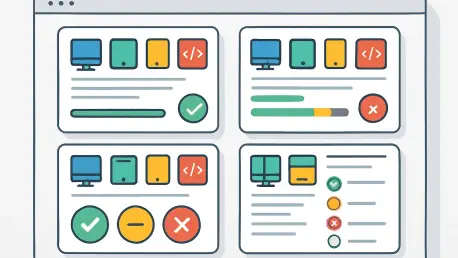Imagine a time when navigating the internet felt like stepping into a maze where every turn led to a different dead end, depending on the browser being used. For much of the web’s early history, developers faced the daunting task of crafting separate code for each browser, as inconsistent rendering and erratic behaviors turned website creation into a grueling ordeal. This chaos wasn’t just a minor inconvenience; it stifled the potential of the internet as a unified global platform. Frustration mounted as coders spent countless hours devising workarounds for browser-specific quirks, longing for a solution that could harmonize the digital landscape. Enter Web Platform Tests (WPT), a groundbreaking initiative that emerged as a beacon of hope, designed to ensure browsers operate in sync. Far from a mere technical patch, WPT has fundamentally reshaped browser development, fostering a culture of collaboration and delivering a more predictable environment for developers worldwide. This transformation didn’t happen overnight, but through a journey from fragmented standards to a shared vision of interoperability, proving that a unified testing framework could tame the wild frontier of the web.
Tracing the Origins of Web Discord
Early Web Struggles
The dawn of the internet brought with it a promise of connectivity, but beneath the surface lay a battleground of mismatched standards that plagued developers for decades. In those formative years, browser vendors such as Microsoft, Mozilla, and Google operated in isolation, each maintaining proprietary test suites that prioritized internal stability over cross-platform compatibility. This siloed approach led to a fractured web where a site functioning seamlessly on Firefox could crash spectacularly on Internet Explorer. Developers found themselves trapped in a cycle of endless adjustments, forced to cater to the whims of each browser’s unique quirks. The lack of a shared testing framework meant that even simple features could behave unpredictably, turning web development into a test of patience rather than skill. This fragmentation wasn’t just a technical hurdle; it represented a fundamental barrier to the internet’s growth as a cohesive ecosystem, leaving the community desperate for a unifying force.
Beyond the immediate frustration, the absence of standardized testing had deeper implications for the web’s credibility as a reliable platform, especially as the internet became integral to daily life. Businesses and users demanded consistency, yet developers struggled to deliver under the weight of browser inconsistencies. Hours that could have been spent innovating were instead squandered on crafting workarounds, with codebases ballooning to accommodate each vendor’s peculiarities. The result was a digital landscape that felt more like a patchwork quilt than a seamless network, undermining trust in the web as a dependable medium. This era of chaos underscored the urgent need for a solution that could bridge the divides between browsers, setting the stage for a radical shift in how compatibility would be approached in the years to come.
Standardization Gaps
As the web evolved, the World Wide Web Consortium (W3C), tasked with guiding internet standards, often prioritized the rapid introduction of new features over the establishment of rigorous testing protocols. Specifications frequently emerged only after browsers had already implemented features, relegating testing to a secondary concern rather than a foundational necessity. This reactive stance meant that interoperability was often an afterthought, leaving developers to navigate a landscape where standards were more theoretical than practical. By the time the web began expanding to diverse devices like smart TVs around a decade ago, the flaws in this approach became impossible to ignore. The lack of a unified testing framework exposed the web’s unpreparedness for broader adoption, revealing a critical gap between ambition and execution.
The shortcomings of this system weren’t just apparent to those within the tech sphere; industries accustomed to stringent testing protocols were stunned by the web’s lax approach, revealing a significant gap in oversight. Sectors like television manufacturing, which relied on precise standards to ensure product reliability, questioned why the internet lacked comparable checks as it integrated into consumer electronics. This external scrutiny highlighted a stark contrast between the web’s innovative spirit and its operational weaknesses, amplifying calls for a more disciplined framework. The pressure from outside industries, combined with internal frustrations, served as a wake-up call for the web community, pushing for a reevaluation of how standards and testing could be aligned to meet the demands of a rapidly diversifying digital world.
Limited Early Efforts
In the quest for browser compatibility, early initiatives like Test262 for JavaScript emerged as specialized tools, focusing on specific components of the web rather than its entirety. While these efforts, supported by contributions from major players like Google and Microsoft, provided some structure for testing scripting languages, they remained narrowly focused and disconnected from the broader needs of web platform interoperability. Such isolated test suites lacked the scope to address the myriad inconsistencies across HTML, CSS, and other core technologies, leaving developers with fragmented resources that failed to solve the larger puzzle. This limited approach meant that while certain areas saw improvement, the overarching challenge of browser discord persisted, underscoring the need for a more comprehensive solution.
Another attempt to gauge browser compliance came through the ACID tests, which initially promised to measure adherence to web standards but soon devolved into little more than marketing ploys. Vendors prioritized achieving high scores on these tests for bragging rights, often at the expense of implementing features with true depth and compatibility. The focus shifted from genuine engineering progress to superficial benchmarks, failing to deliver the practical tools developers needed to ensure consistent performance across platforms. This misstep revealed a critical flaw in early testing efforts: without a unified, practical framework, even well-intentioned initiatives could fall short of addressing the web’s deeper interoperability issues, paving the way for a more robust and inclusive approach to emerge.
Emergence of a Unified Testing Framework
A Grassroots Solution
Amid the chaos of browser incompatibility, a flicker of hope emerged in the early 2010s with the inception of Web Platform Tests (WPT), a project born from shared frustration and a vision for a harmonized web. Initially a modest endeavor within the W3C, WPT aimed to consolidate disparate tests into a single, accessible repository that all browsers could utilize. However, the journey was far from smooth, as funding remained elusive and support from major stakeholders was tepid at best. Despite these setbacks, grassroots efforts fueled by passionate individuals and contributions from companies like Adobe helped build early momentum through community-driven initiatives. Events such as Test the Web Forward rallied developers and engineers to contribute, even if the quality of initial tests varied, laying the groundwork for a collaborative testing culture that prioritized accountability over competition.
The significance of WPT’s early struggles cannot be overstated, as they forged a resilient foundation rooted in community spirit rather than corporate mandates, setting the stage for a unique and independent path forward. This independence, ironically born from a lack of substantial backing, allowed WPT to position itself as a neutral entity, free from the influence of any single browser vendor or standards body. Engineers began to recognize the value of a shared testing ground that could hold all parties to the same standards, fostering a sense of collective responsibility. Though progress was slow and resources scarce, these formative years established WPT as a beacon of potential, demonstrating that even a small, determined group could challenge the status quo of web development and push for a future where interoperability was the norm.
Gaining Traction
By 2016, the tides began to turn for WPT as major browser vendors recognized its potential to transform their development processes, marking a pivotal moment in its journey toward prominence. Google took a significant step by integrating WPT into Chrome’s engineering workflows, not only adopting the test suite but also funding infrastructure enhancements through partnerships with organizations like Bocoup. This move signaled a growing acceptance of shared testing as a fundamental principle, prompting other giants like Apple, Mozilla, and Microsoft to follow suit by synchronizing their own systems with WPT’s evolving framework. What began as a scrappy, underfunded initiative started to solidify into a cornerstone of modern browser creation, proving its worth through tangible improvements in compatibility.
This widespread adoption among industry leaders underscored a broader shift in perspective, where the benefits of a unified testing suite became undeniable even to former skeptics. As vendors aligned their efforts with WPT, the project gained access to greater resources and expertise, enabling it to expand its scope and refine its methodologies. The collaborative momentum fostered a feedback loop where improved tests led to better browser implementations, which in turn informed more robust testing standards. This period of rapid integration highlighted WPT’s role not just as a tool, but as a catalyst for systemic change, embedding interoperability into the DNA of browser development and setting a precedent for how shared resources could drive industry-wide progress.
Mechanics and Obstacles of a Testing Powerhouse
How WPT Works
At its core, Web Platform Tests operates as a sophisticated yet accessible system, leveraging familiar technologies like HTML, JavaScript, and CSS to scrutinize browser behavior with precision. With millions of sub-tests grouped into tens of thousands of main tests, WPT evaluates everything from basic rendering tasks—such as displaying a simple box on a screen—to intricate user interactions that mimic real-world usage. A Python-based test harness underpins this framework, paired with a basic HTTP server for local execution, while tools like WebDriver enable automation of complex scenarios that JavaScript alone cannot handle. This technical setup ensures that browsers are held to consistent standards, providing developers with the confidence that their code will perform predictably across different platforms, a stark contrast to the guesswork of earlier eras.
The true strength of WPT lies in its ability to bridge the gap between theoretical standards and practical implementation, serving as a litmus test for browser compliance. By simulating a vast array of scenarios, from routine page loads to edge-case interactions, the suite identifies discrepancies that could otherwise disrupt user experiences. Its open nature allows for continuous updates and refinements, ensuring that as web technologies evolve, so too does the testing framework. This adaptability has made WPT an indispensable asset, reducing the uncertainty that once plagued developers and enabling a more streamlined approach to building for the web. The result is a digital environment where consistency is no longer an aspiration but a measurable, achievable reality.
Ongoing Challenges
Despite its transformative impact, WPT faces significant hurdles in keeping pace with the web’s relentless expansion into new domains and devices. As the internet permeates everything from mobile gadgets to smart appliances, achieving full test coverage for every feature and context remains an elusive goal. Areas such as accessibility tools for screen readers and emerging technologies like service workers present unique testing difficulties, often requiring innovative approaches like the bidirectional WebDriver protocol to address them. These gaps in coverage highlight the dynamic nature of the web platform, where growth outstrips even the most comprehensive testing efforts, posing a constant challenge to maintain relevance and effectiveness in an ever-shifting landscape.
Nevertheless, even with these limitations, WPT delivers immense value by preventing browser vendors from duplicating efforts on redundant testing infrastructures. By providing a shared resource, it saves countless hours and resources that would otherwise be spent on proprietary test suites, allowing engineers to focus on innovation rather than repetition. The challenge of incomplete coverage is mitigated by ongoing collaborations among vendors to prioritize critical areas, ensuring that the most pressing interoperability issues are addressed first. As the web continues to diversify, the adaptability of WPT’s framework and the commitment of its contributors remain vital, offering a pathway to close existing gaps while preparing for future complexities that lie ahead.
Shifting Dynamics in Browser Creation
From Rivals to Partners
One of the most remarkable outcomes of Web Platform Tests has been its role in reshaping the competitive landscape of browser development into a collaborative arena. Historically, vendors like Google, Apple, Mozilla, and Microsoft viewed each other as adversaries, often prioritizing proprietary features over shared standards to gain a market edge. However, WPT introduced a paradigm shift by demonstrating that interoperability benefits all stakeholders, fostering a culture where mutual progress trumps individual gain. This transformation saw former rivals aligning their engineering processes around a common testing framework, acknowledging that a reliable web platform enhances value for everyone—from increased ad revenue for some to boosted device sales for others.
This cultural pivot was not merely symbolic; it embedded a new ethos into the fabric of browser creation, where shared accountability became a guiding principle. Engineers across companies began to see WPT not as a constraint but as a tool for collective improvement, driving decisions that prioritized compatibility over differentiation. The shift dismantled long-standing barriers, replacing zero-sum competition with a cooperative mindset that recognized the web’s strength as a unified ecosystem. This newfound camaraderie laid the foundation for initiatives that further cemented collaboration, proving that even in a competitive industry, a shared commitment to testing could redefine relationships and elevate the entire digital experience.
Collaborative Initiatives
Building on the cooperative spirit fostered by WPT, initiatives like Interop have emerged as powerful mechanisms to target and resolve the web’s most persistent compatibility weak spots. Conducted annually among major browser makers, Interop leverages WPT results to identify areas with poor interoperability scores, often informed by developer feedback and surveys covering HTML, CSS, and JavaScript trends. By focusing test development and implementation efforts on these critical pain points, the initiative ensures that features essential to developers are uniformly supported across platforms. Tools such as the Interop dashboard provide transparency, mapping test outcomes to specific functionalities and exposing gaps that need attention.
The impact of Interop extends beyond mere technical fixes, as it reinforces a shared commitment to a seamless web experience among vendors who once operated in isolation. This collaborative approach has accelerated the standardization of key features, ensuring they achieve broad, accurate implementation before becoming industry baselines. Additionally, it bridges historical divides between organizations like W3C and WHATWG, aligning their efforts on common deliverables through a focus on testing. The synergy between WPT data and initiatives like Interop exemplifies how structured collaboration can transform abstract goals into concrete outcomes, continuously enhancing the web’s reliability for developers and users alike.
Broadening Participation in Web Testing
Developer Involvement
While Web Platform Tests have been predominantly shaped by browser engineers and system developers, engaging the wider web developer community remains a persistent goal with notable challenges. Writing high-quality tests for WPT demands significant expertise and time, creating a steep learning curve that deters many from contributing. Most developers, often constrained by tight project deadlines, struggle to see immediate benefits in crafting tests that may only influence browser versions years down the line. Despite initiatives aimed at lowering these barriers, such as community events and outreach programs, participation from the broader developer base remains limited, highlighting a disconnect between the testing framework’s potential and its accessibility.
However, the value of involving web developers in WPT cannot be understated, as their real-world insights could directly address specific bugs or features critical to everyday applications. Businesses relying heavily on web technologies, such as e-commerce platforms, could play a pivotal role by contributing tests that reflect their unique needs, thereby influencing browser development while benefiting the entire ecosystem. Although current engagement levels fall short of the ideal, the pursuit of public accountability through community investment continues to be a worthy endeavor. Efforts to simplify contribution processes and demonstrate tangible impacts are essential to bridging this gap, ensuring that WPT reflects the practical demands of those building the web, not just the technical priorities of vendors.
Expanding Community Reach
To maximize its impact, WPT must evolve strategies that make participation more feasible for a diverse array of contributors beyond traditional browser engineers. Educational resources and streamlined tools could demystify the testing process, empowering developers with varying levels of expertise to add value without feeling overwhelmed. Online platforms and forums dedicated to WPT contributions could foster a sense of community, offering guidance and recognition to those who invest their time. By reducing the perceived complexity and time commitment, these measures could encourage a broader demographic to engage, enriching the test suite with perspectives that mirror the web’s vast user base.
Moreover, partnerships with academic institutions and coding bootcamps could cultivate interest in WPT among emerging developers, embedding testing principles early in their careers. Highlighting success stories where community-contributed tests resolved significant issues might also inspire greater involvement, illustrating the direct influence individuals can have on browser evolution. While the road to widespread developer participation is fraught with obstacles, persistent efforts to make WPT more inclusive hold the promise of a more robust and representative testing framework. Such inclusivity would ensure that the web remains a platform shaped by its users, addressing real-world needs through a collective commitment to interoperability.
Reflecting on a Unified Digital Future
A Stabilized Web
Looking back, the journey of Web Platform Tests stands as a testament to the power of shared vision in overcoming the web’s once-crippling incompatibilities. What began as a modest collection of disparate tests grew into an indispensable pillar of browser development, eliminating the need for cumbersome CSS hacks and exhaustive cross-browser testing that defined an earlier era. Developers came to rely on a platform where features, once shipped, were expected to function consistently across browsers—an expectation that would have been unimaginable without WPT’s rigorous framework. This stabilization not only eased the burden on coders but also accelerated the adoption of new standards, ensuring that innovation kept pace with reliability for billions of users worldwide.
The ripple effects of this transformation touched every corner of the digital landscape, proving that a collaborative testing model could yield benefits far beyond technical metrics. WPT’s influence fostered a web where trust in cross-platform performance became the norm, empowering developers to focus on creativity rather than troubleshooting. Its role in harmonizing browser behavior provided a foundation for the internet to flourish as a truly global medium, accessible across an array of devices and contexts. As a stabilizing force, WPT laid the groundwork for a more seamless online experience, reflecting a past where persistent challenges were met with enduring solutions that reshaped the web’s trajectory.
Charting the Path Ahead
Reflecting on the strides made, the legacy of Web Platform Tests offers clear next steps for sustaining and expanding its impact on the web’s future, ensuring that progress continues unabated. Continued investment in test coverage must prioritize emerging areas like mobile ecosystems and accessibility tools, ensuring that as the internet integrates into new devices, interoperability remains uncompromised. Strengthening partnerships among browser vendors through initiatives like Interop should focus on preemptively addressing compatibility issues, using developer feedback to guide priorities. Additionally, simplifying contribution pathways for the broader community could unlock a wealth of practical insights, making WPT a true reflection of the web’s diverse needs.
Beyond immediate technical goals, exploring WPT’s collaborative model as a blueprint for other fields—such as accessibility standards or UI libraries—holds immense potential to standardize solutions across varied domains and encourages cross-industry dialogue. This approach could further refine solutions by adapting lessons learned from the web to enhance interoperability elsewhere. As logistical and competitive challenges persist, maintaining a dedicated core team to navigate these dynamics will be crucial. Ultimately, WPT’s enduring role as a catalyst for innovation and reliability invites a proactive commitment to evolve alongside the web, ensuring that future generations of developers and users inherit a platform defined by unity and dependability.









